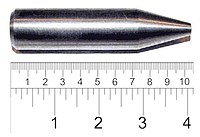
Photo from wikipedia
Abstract Low-salinity water flooding (LSW) effects are generated by the reduction of ionic concentration of environment electrolytes to which thin brine films confined between oil and rock are exposed. We… Click to show full abstract
Abstract Low-salinity water flooding (LSW) effects are generated by the reduction of ionic concentration of environment electrolytes to which thin brine films confined between oil and rock are exposed. We study the dynamics of ion depletion from thin brine films upon a reduction of environment electrolyte concentration using the Poisson-Nernst-Planck (PNP) model. Interestingly, the model predicts that the timescale of ion depletion is not prolonged, but slightly shortened, by charged oil and rock surfaces in comparison with the absence of surface charges. This phenomenon is also reproduced quantitatively using a reduced ion depletion model inspired by the membrane science literature, in which salt diffusion and Donnan equilibrium between brine film and environment are considered. Furthermore, the self-diffusion of ions confined between n-decane and negatively charged quartz surface is investigated via atomistic simulations. It is found that, on average, the diffusion of ions in nanometer-thin brine films is slowed down up to ~8 times compared to that in bulk, although the slowdown relevant to ion depletion in event of a salinity reduction in the environment is most likely only about 2–3 times. These results provide new, pore-scale insights into LSW processes. The reduced salt depletion model and molecular simulation of ion diffusion demonstrated here help to develop a multiscale, bottom-up modeling framework for predicting LSW processes.
Journal Title: Fuel
Year Published: 2021
Link to full text (if available)
Share on Social Media: Sign Up to like & get
recommendations!